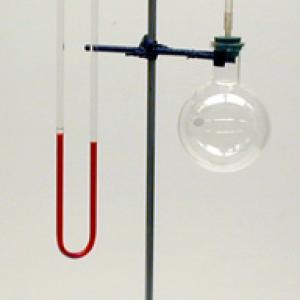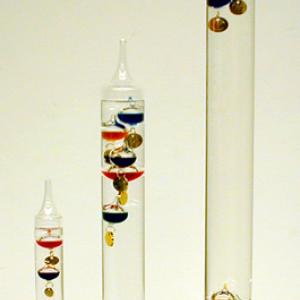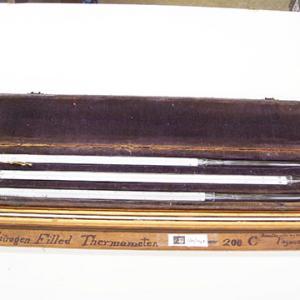College of Liberal Arts & Sciences
4A10.10 - Thermometers - Gas and Liquid
Gas Thermometer - Colored water will have to be added to the demo as needed. Several drops of oil added to the top of the water on the open side of the U-tube will help to slow evaporation. Warming the flask with both hands is all that is needed, although a Bunsen burner may be used for short periods of time.
CAUTION: The mercury thermometers need to have special handling as they are now considered hazardous waste if broken.
The homemade alcohol thermometers were made by physics and chemistry students as a lab project circa 1900 to 1930 or earlier. They work well but because of their large liquid volume they take a long while to come to measured temperature.
The maximum-minimum thermometer has small plugs that ride on top of the mercury columns. The plugs will remain in place and show the maximum and minimum temperatures recorded for a desired time period.
Examples of other large precision mercury thermometers are available for viewing.
- Thomas B. Greenslade Jr., "The Homigrade Thermometer", TPT, Vol. 46, #9, Dec. 2008, p. 548.
- Lawrence Day, "Converting Between °C and °F: A Teachable Moment", TPT, Vol. 45, #5, May 2007, p. 285.
- Frank Lock, "Modeling and Measurement", TPT, Vol. 45, #2, Feb. 2007, p. 68.
- H. L. Neal, "Temperature Transformation Equations", TPT, Vol. 44, #7, Oct. 2006, p. 455.
- Philip Gash, "So You Thought a Glass Thermometer Measured Temperature", TPT, Vol. 40, #2, Feb. 2002, p. 74.
- Carl J. Wenning, "A Variation on Temperature Conversion", TPT, Vol. 39, #8, Oct. 2001, p. 434.
- David Wheeler and Eric Mazur, "The Great Thermometer Challenge", TPT, Vol. 38, #4, Apr. 2000, p. 235.
- Mark P. Silverman and Christopher R. Silverman, "Cool in the Kitchen: Radiation, Conduction, and the Newton 'Hot Block' Experiment", TPT, Vol. 38, #2, Feb. 2000, p. 82.
- H. Richard Crane, "A Thermometer Whose Memory Is A One-Sided Magnet", TPT, Vol. 37, #3, Mar. 1999, p. 148.
- Volker Thomsen, "Response Time of a Thermometer", TPT, Vol. 36, #9, Dec. 1998, p. 540.
- Dennis McKinney, "Min-Max Thermometers", TPT, Vol. 36, #6, Sept. 1998, p. 324.
- H. Richard Crane, "Why Shake Your Fever Thermometer?—and More", TPT, Vol. 36, #3, Mar. 1998, p. 142.
- Lawrence Day, "Hot to Cold and Back Again", TPT, Vol. 35, #4, Apr. 1997, p. 197.
- Martin Gardner, "Two Stunts with a Bottle", TPT, Vol. 35, #1, Jan. 1997, p. 53.
- A. P. French, "Newton's Thermometry: The Role of Radiation", TPT, Vol. 31, #5, May 1993, p. 310.
- A. P. French, "Isaac Newton's Thermometry", TPT, Vol. 31, #4, Apr. 1993, p. 208.
- Mario Iona, "Another View by Iona", TPT, Vol. 28, #7, Oct. 1990, p. 444.
- Ralf Baierlein, "Baierlein's Response to Alonso and Munley", TPT, Vol. 28, #7, Oct. 1990, p. 442.
- Frank Munley, "Comment II by Munley", TPT, Vol. 28, #7, Oct. 1990, p. 441.
- Marselo Alonso, "Comment I by Alonso", TPT, Vol. 28, #7, Oct. 1990, p. 441.
- Ralph Baierlein, "The Meaning of Temperature", TPT, Vol. 28, #2, Feb. 1990, p. 94.
- Manfred Bucher and Hugh A. Williamson, "Conversion of Temperature Scales", TPT, Vol. 24, #5, May 1986, p. 288.
- Haym Kruglak, "Sic Transit Gloria", TPT, Vol. 22, #6, Sept. 1984, p. 350.
- F. Neff Weber, "Temperature Conversion Technique", TPT, Vol. 21, #8, Nov. 1983, p. 535.
- F. Esmael, "Temperature - A Question of Choice", TPT, Vol. 21, #1, Jan. 1983, p. 38.
- A. J. Nicastro, "Dalton's Temperature Scale", TPT, Vol. 21, #1, Jan. 1983, p. 6.
- E. Scott Barr, "Comments on the October Issue", TPT, Vol. 20, #9, Dec. 1982, p. 578.
- Robert H. Romer, "Temperature Scales: Celsius, Fahrenheit, Kelvin, Réamur, and Rømer", TPT, Vol. 20, #7, Oct. 1982, p. 450.
- E. Scott Barr, "A Third Scale", TPT, Vol. 19, #2, Feb. 1981, p. 82.
- Edwin R. Jones Jr., "Fahrenheit and Celsius, A History", TPT, Vol. 18, #8, Nov. 1980, p. 594.
- C. T. Haywood, "Temperature and the Transfer of Heat", TPT, Vol. 14 #6, Sept. 1976, p. 366.
- Mario Iona, "'Would You Believe...?': History of the Fahrenheit Scale", TPT, Vol. 11, #8, Nov. 1973, p. 503.
- Charles L. Roberts, "Apparatus for Teaching Physics: Repairing Thermometers with Split Mercury Columns", TPT, Vol. 6, #8, Nov. 1968, p. 427, also A Potpourri of Physics Teaching Ideas - Heat and Fluids, p. 120.
- Thomas B. Greenslade, Jr., "Maximum-Minimum Thermometer", AJP, Vol. 80, #10, Oct. 2012, p. 861.
- Ronald Geballe, "Note on 'A Thermometer Based on Archimedes' Principle' by George D. Nickas [Am. J. Phys. 57, 845-846 (1989)]", AJP, Vol. 59, #1, Jan. 1991, p. 90.
- George D. Nickas, "A Thermometer Based on Archimedes' Principle", AJP, Vol. 57, #9, Sept. 1989, p. 845.
- James Evans and Brian Popp, "Pictet's Experiment: The Apparent Radiation and Reflection of Cold", AJP, Vol. 53, #8, Aug. 1985, p. 737.
- Shawn Carlson, "The Amateur Scientist: A Home-Made Precision Thermometer", Scientific American, Vol. 280, #3, Mar. 1999, p. 102.
- Harry M. Davis, "Low Temperature Physics", Scientific American,Vol. 180, #6, June 1949, p. 30.
- Daniel Engber, "Ask Anything: What's The Hottest Temperature Possible?", Popular Science, Vol. 286, #11, Nov. 2014, p. 78.
- D. Rae Carpenter Jr. and Richard B. Minnix, "H-018. Liquid Xtal-Galileo's Thermom", DICK and RAE Physics Demo Notebook, 1993.
- G. D. Freier and F. J. Anderson, "Ha-2", A Demonstration Handbook for Physics.
- Tik Liem, "Withdrawing Juices", Investigation to Science Inquiry, p. 212.
- Tik Liem, "The Rising Juices", Investigation to Science Inquiry, p. 211.
- R.W. Pohl, "2. The Free Movement of Molecules in a Liquid: the Brownian Movement", Physical Principles of Mechanics and Acoustics, p. 152.
- "Gabriel Daniel Fahrenheit", Uncle John's Bathroom Reader, p. 161.
- Janice VanCleave, "13. Expanding Balloon", Teaching the Fun of Physics, p. 24.
- Janice VanCleave, "12. Popping Coin", Teaching the Fun of Physics, p. 23.
- Janice VanCleave, "11. A Bottle Thermometer", Teaching the Fun of Physics, p. 22.
- Janice VanCleave, "175. Thermometer", Janice VanCleave's 203 Icy, Freezing, Frosty, Cool, and Wild Experiments.
- Robert L. Wild, "84. Thermometry - Air Thermometers", Low-Cost Physics Demonstrations, p. 52.
- John H. Moore, Christopher C. Davis, and Michael A. Coplan, "Expansion Thermometers", Building Scientific Apparatus 2nd Edition, p. 510 - 511.
- Yaakov Kraftmakher, "7.18. Absolute Temperature Scale", Experiments and Demonstrations in Physics, ISBN 981-256-602-3, p. 489.
- Bobby Mercer, "Coin Dance", Junk Drawer Chemistry, 2016, p. 178 - 180.
- Julius Sumner Miller, Q34 & A34, Millergrams I – Some Enchanting Questions for Enquiring Minds, p. 32 & 88.
- Joseph Frick, "# 342 & 343 - The Thermometer & Construction of Thermometers", Physical Technics: Or Practical Instructions for Making Experiments in Physics and the Construction of Physical Apparatus with the Most Limmited Means, p. 405.
- Abigal Dove, "PHYSICS HISTORY - May 24, 1686: Daniel Gabriel Fahrenheit and the Birth of Precision Thermometry", APS News, Vol. 31, #5, May 2022, p. 2.
Disclaimer: These demonstrations are provided only for illustrative use by persons affiliated with The University of Iowa and only under the direction of a trained instructor or physicist. The University of Iowa is not responsible for demonstrations performed by those using their own equipment or who choose to use this reference material for their own purpose. The demonstrations included here are within the public domain and can be found in materials contained in libraries, bookstores, and through electronic sources. Performing all or any portion of any of these demonstrations, with or without revisions not depicted here entails inherent risks. These risks include, without limitation, bodily injury (and possibly death), including risks to health that may be temporary or permanent and that may exacerbate a pre-existing medical condition; and property loss or damage. Anyone performing any part of these demonstrations, even with revisions, knowingly and voluntarily assumes all risks associated with them.



